Managerial Economics Assessment 1 for Unilever's Dove Soap
VerifiedAdded on 2023/06/18
|11
|3351
|432
AI Summary
This assessment analyzes the demand and market equilibrium for Unilever's Dove Soap. It includes a brief history of Unilever, description of its products and services, and factors that influence demand for Dove Soap. It also indicates whether demand is more elastic or inelastic and suggests pricing policies for Unilever. The subject is Management Economics and the course code is not mentioned. The college/university is not mentioned.
Contribute Materials
Your contribution can guide someone’s learning journey. Share your
documents today.
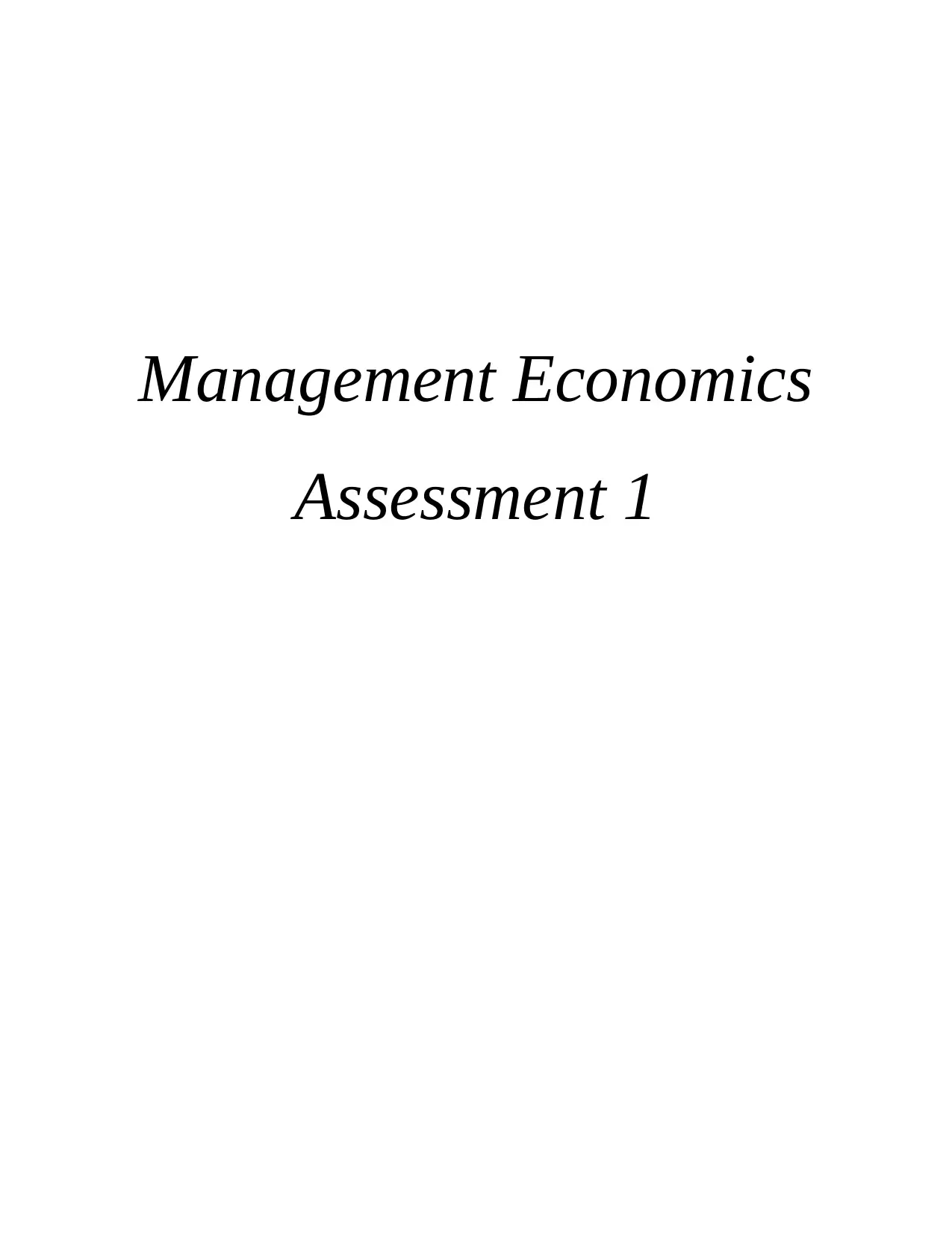
Management Economics
Assessment 1
Assessment 1
Secure Best Marks with AI Grader
Need help grading? Try our AI Grader for instant feedback on your assignments.
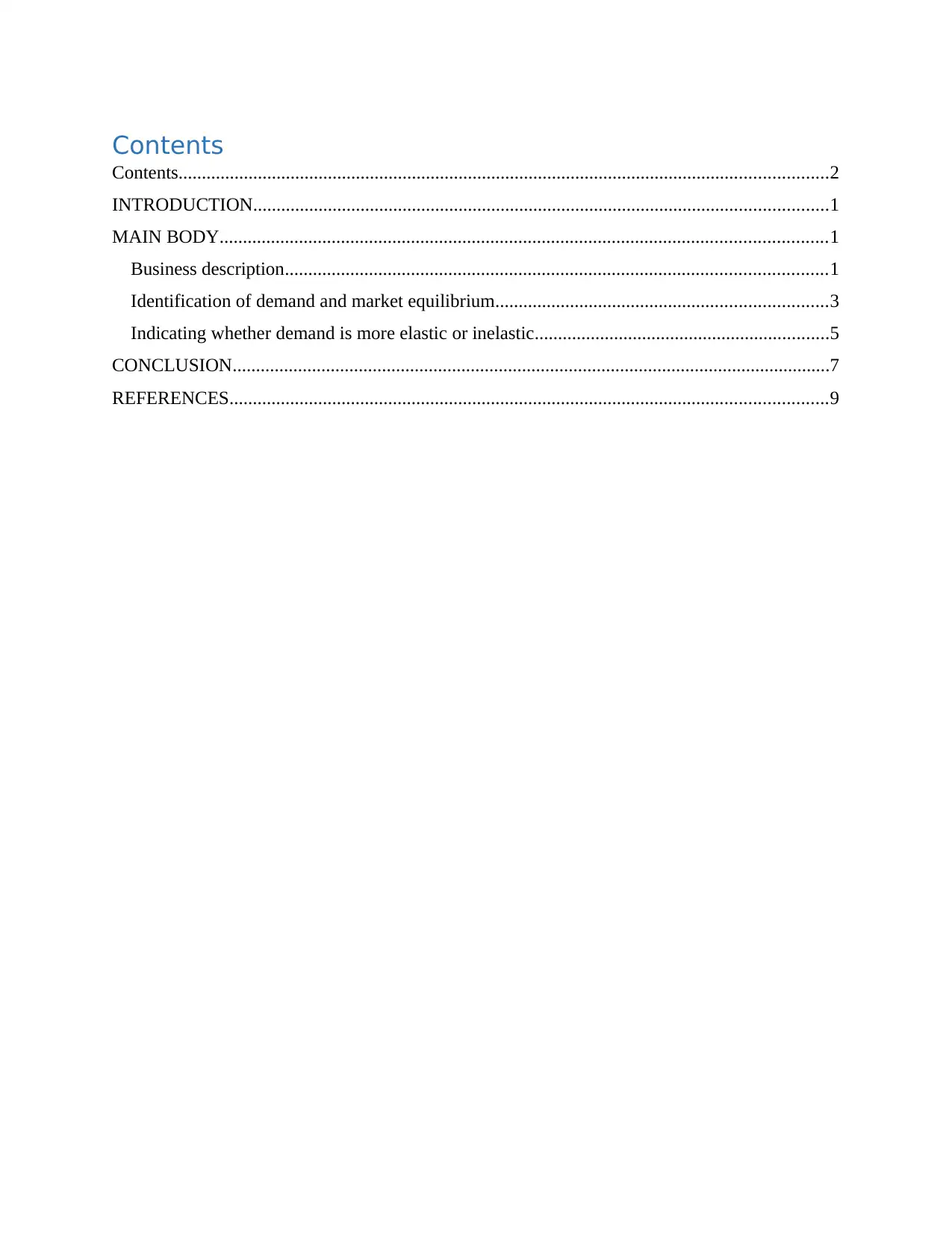
Contents
Contents...........................................................................................................................................2
INTRODUCTION...........................................................................................................................1
MAIN BODY..................................................................................................................................1
Business description....................................................................................................................1
Identification of demand and market equilibrium.......................................................................3
Indicating whether demand is more elastic or inelastic...............................................................5
CONCLUSION................................................................................................................................7
REFERENCES................................................................................................................................9
Contents...........................................................................................................................................2
INTRODUCTION...........................................................................................................................1
MAIN BODY..................................................................................................................................1
Business description....................................................................................................................1
Identification of demand and market equilibrium.......................................................................3
Indicating whether demand is more elastic or inelastic...............................................................5
CONCLUSION................................................................................................................................7
REFERENCES................................................................................................................................9
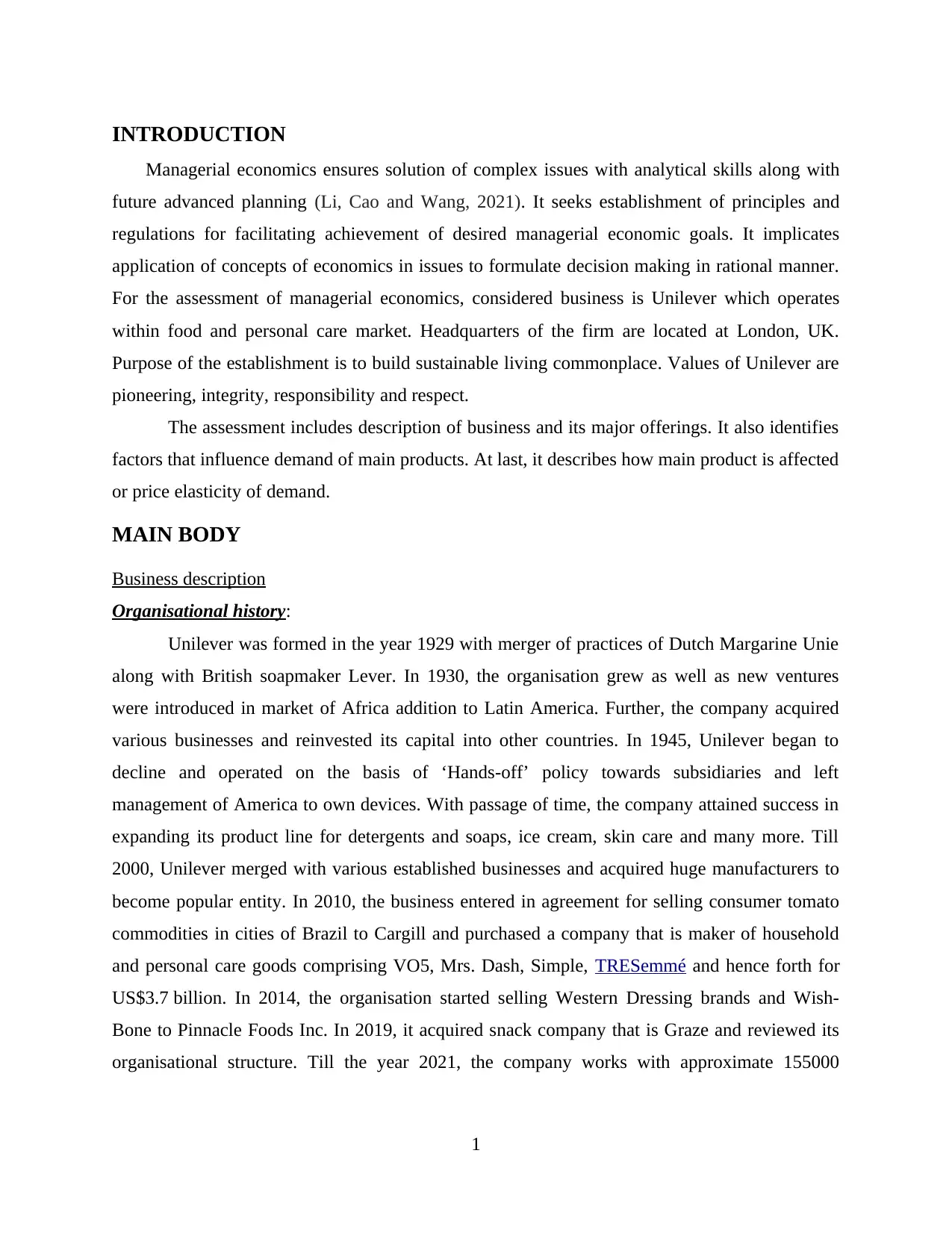
INTRODUCTION
Managerial economics ensures solution of complex issues with analytical skills along with
future advanced planning (Li, Cao and Wang, 2021). It seeks establishment of principles and
regulations for facilitating achievement of desired managerial economic goals. It implicates
application of concepts of economics in issues to formulate decision making in rational manner.
For the assessment of managerial economics, considered business is Unilever which operates
within food and personal care market. Headquarters of the firm are located at London, UK.
Purpose of the establishment is to build sustainable living commonplace. Values of Unilever are
pioneering, integrity, responsibility and respect.
The assessment includes description of business and its major offerings. It also identifies
factors that influence demand of main products. At last, it describes how main product is affected
or price elasticity of demand.
MAIN BODY
Business description
Organisational history:
Unilever was formed in the year 1929 with merger of practices of Dutch Margarine Unie
along with British soapmaker Lever. In 1930, the organisation grew as well as new ventures
were introduced in market of Africa addition to Latin America. Further, the company acquired
various businesses and reinvested its capital into other countries. In 1945, Unilever began to
decline and operated on the basis of ‘Hands-off’ policy towards subsidiaries and left
management of America to own devices. With passage of time, the company attained success in
expanding its product line for detergents and soaps, ice cream, skin care and many more. Till
2000, Unilever merged with various established businesses and acquired huge manufacturers to
become popular entity. In 2010, the business entered in agreement for selling consumer tomato
commodities in cities of Brazil to Cargill and purchased a company that is maker of household
and personal care goods comprising VO5, Mrs. Dash, Simple, TRESemmé and hence forth for
US$3.7 billion. In 2014, the organisation started selling Western Dressing brands and Wish-
Bone to Pinnacle Foods Inc. In 2019, it acquired snack company that is Graze and reviewed its
organisational structure. Till the year 2021, the company works with approximate 155000
1
Managerial economics ensures solution of complex issues with analytical skills along with
future advanced planning (Li, Cao and Wang, 2021). It seeks establishment of principles and
regulations for facilitating achievement of desired managerial economic goals. It implicates
application of concepts of economics in issues to formulate decision making in rational manner.
For the assessment of managerial economics, considered business is Unilever which operates
within food and personal care market. Headquarters of the firm are located at London, UK.
Purpose of the establishment is to build sustainable living commonplace. Values of Unilever are
pioneering, integrity, responsibility and respect.
The assessment includes description of business and its major offerings. It also identifies
factors that influence demand of main products. At last, it describes how main product is affected
or price elasticity of demand.
MAIN BODY
Business description
Organisational history:
Unilever was formed in the year 1929 with merger of practices of Dutch Margarine Unie
along with British soapmaker Lever. In 1930, the organisation grew as well as new ventures
were introduced in market of Africa addition to Latin America. Further, the company acquired
various businesses and reinvested its capital into other countries. In 1945, Unilever began to
decline and operated on the basis of ‘Hands-off’ policy towards subsidiaries and left
management of America to own devices. With passage of time, the company attained success in
expanding its product line for detergents and soaps, ice cream, skin care and many more. Till
2000, Unilever merged with various established businesses and acquired huge manufacturers to
become popular entity. In 2010, the business entered in agreement for selling consumer tomato
commodities in cities of Brazil to Cargill and purchased a company that is maker of household
and personal care goods comprising VO5, Mrs. Dash, Simple, TRESemmé and hence forth for
US$3.7 billion. In 2014, the organisation started selling Western Dressing brands and Wish-
Bone to Pinnacle Foods Inc. In 2019, it acquired snack company that is Graze and reviewed its
organisational structure. Till the year 2021, the company works with approximate 155000
1
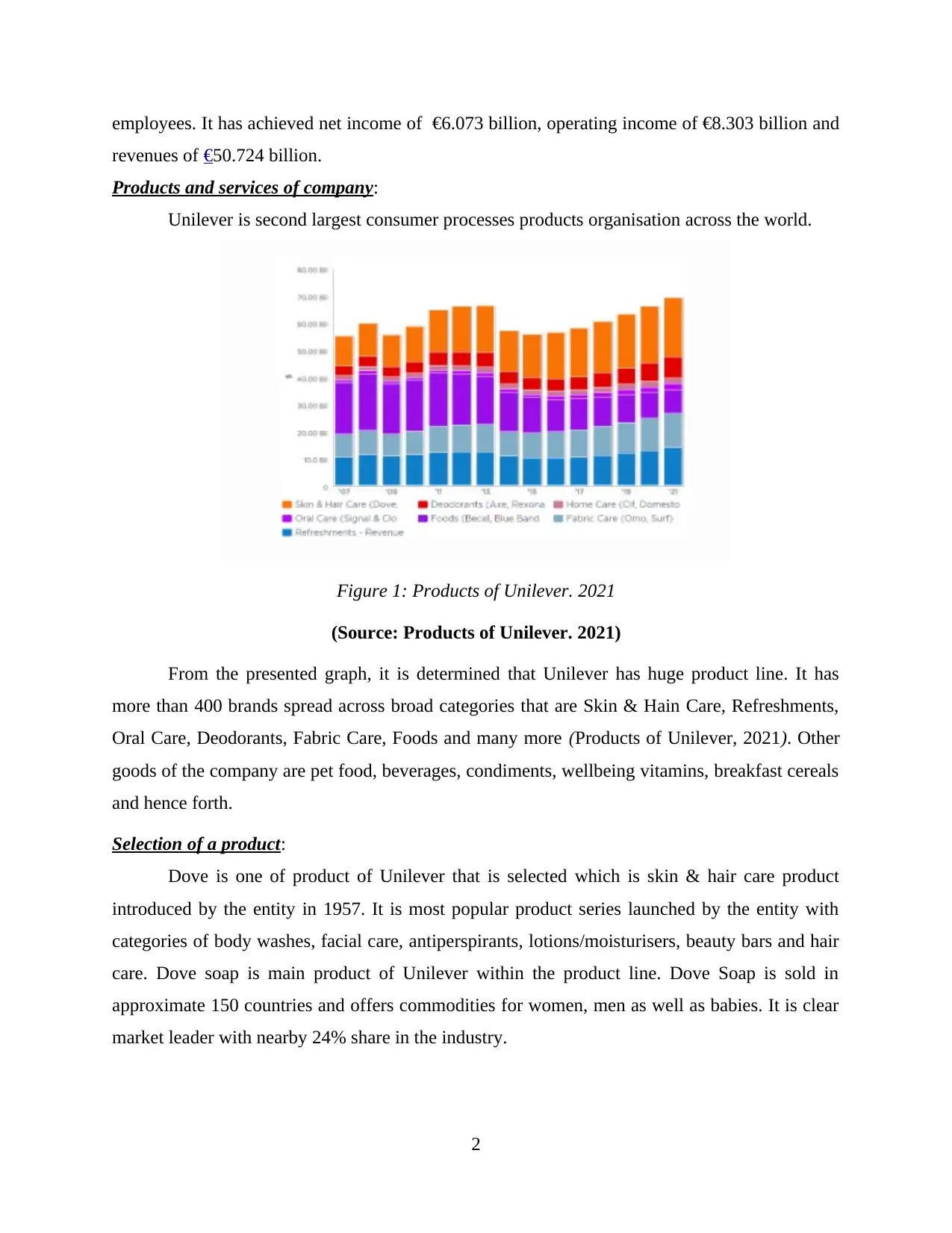
employees. It has achieved net income of €6.073 billion, operating income of €8.303 billion and
revenues of €50.724 billion.
Products and services of company:
Unilever is second largest consumer processes products organisation across the world.
Figure 1: Products of Unilever. 2021
(Source: Products of Unilever. 2021)
From the presented graph, it is determined that Unilever has huge product line. It has
more than 400 brands spread across broad categories that are Skin & Hain Care, Refreshments,
Oral Care, Deodorants, Fabric Care, Foods and many more (Products of Unilever, 2021). Other
goods of the company are pet food, beverages, condiments, wellbeing vitamins, breakfast cereals
and hence forth.
Selection of a product:
Dove is one of product of Unilever that is selected which is skin & hair care product
introduced by the entity in 1957. It is most popular product series launched by the entity with
categories of body washes, facial care, antiperspirants, lotions/moisturisers, beauty bars and hair
care. Dove soap is main product of Unilever within the product line. Dove Soap is sold in
approximate 150 countries and offers commodities for women, men as well as babies. It is clear
market leader with nearby 24% share in the industry.
2
revenues of €50.724 billion.
Products and services of company:
Unilever is second largest consumer processes products organisation across the world.
Figure 1: Products of Unilever. 2021
(Source: Products of Unilever. 2021)
From the presented graph, it is determined that Unilever has huge product line. It has
more than 400 brands spread across broad categories that are Skin & Hain Care, Refreshments,
Oral Care, Deodorants, Fabric Care, Foods and many more (Products of Unilever, 2021). Other
goods of the company are pet food, beverages, condiments, wellbeing vitamins, breakfast cereals
and hence forth.
Selection of a product:
Dove is one of product of Unilever that is selected which is skin & hair care product
introduced by the entity in 1957. It is most popular product series launched by the entity with
categories of body washes, facial care, antiperspirants, lotions/moisturisers, beauty bars and hair
care. Dove soap is main product of Unilever within the product line. Dove Soap is sold in
approximate 150 countries and offers commodities for women, men as well as babies. It is clear
market leader with nearby 24% share in the industry.
2
Secure Best Marks with AI Grader
Need help grading? Try our AI Grader for instant feedback on your assignments.
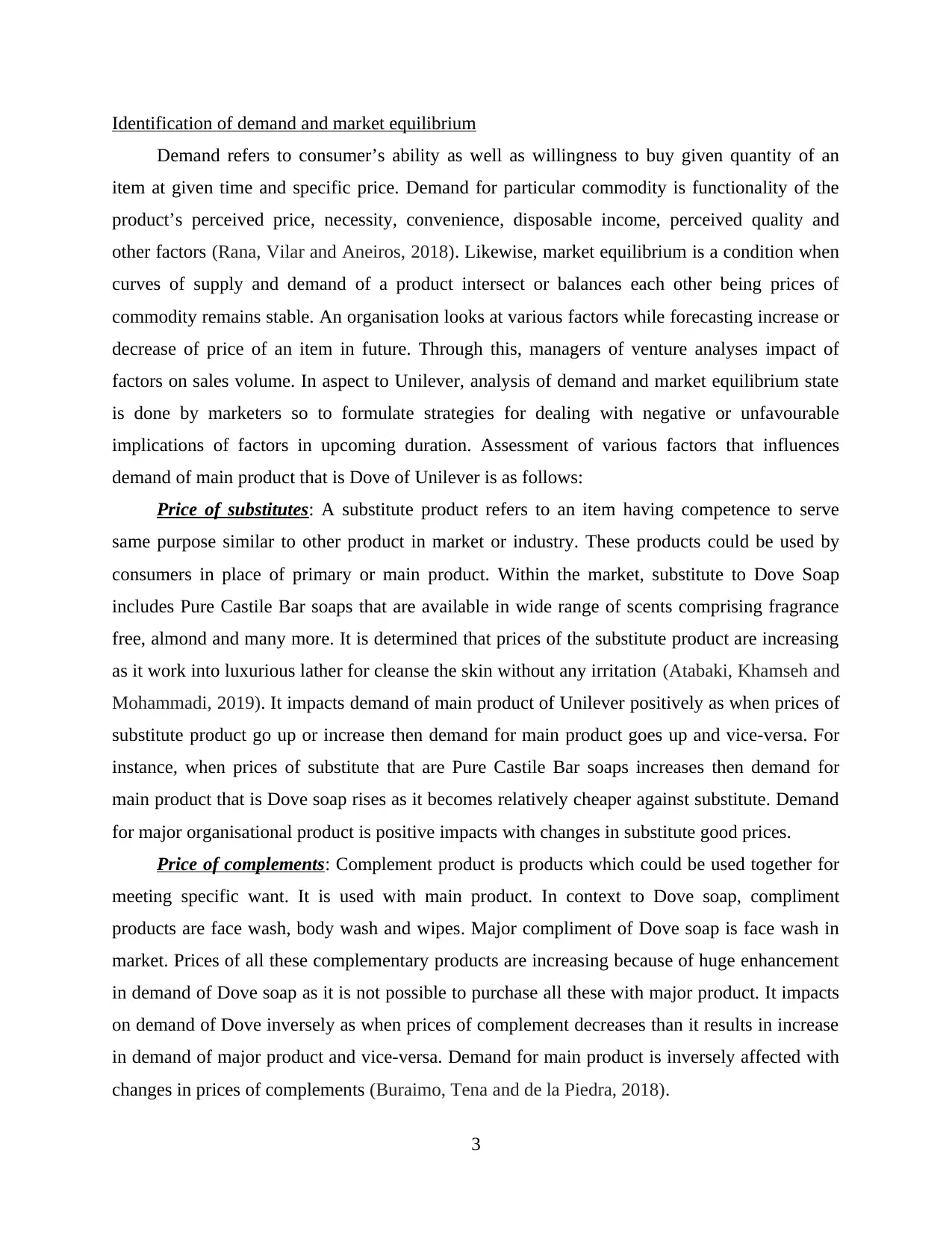
Identification of demand and market equilibrium
Demand refers to consumer’s ability as well as willingness to buy given quantity of an
item at given time and specific price. Demand for particular commodity is functionality of the
product’s perceived price, necessity, convenience, disposable income, perceived quality and
other factors (Rana, Vilar and Aneiros, 2018). Likewise, market equilibrium is a condition when
curves of supply and demand of a product intersect or balances each other being prices of
commodity remains stable. An organisation looks at various factors while forecasting increase or
decrease of price of an item in future. Through this, managers of venture analyses impact of
factors on sales volume. In aspect to Unilever, analysis of demand and market equilibrium state
is done by marketers so to formulate strategies for dealing with negative or unfavourable
implications of factors in upcoming duration. Assessment of various factors that influences
demand of main product that is Dove of Unilever is as follows:
Price of substitutes: A substitute product refers to an item having competence to serve
same purpose similar to other product in market or industry. These products could be used by
consumers in place of primary or main product. Within the market, substitute to Dove Soap
includes Pure Castile Bar soaps that are available in wide range of scents comprising fragrance
free, almond and many more. It is determined that prices of the substitute product are increasing
as it work into luxurious lather for cleanse the skin without any irritation (Atabaki, Khamseh and
Mohammadi, 2019). It impacts demand of main product of Unilever positively as when prices of
substitute product go up or increase then demand for main product goes up and vice-versa. For
instance, when prices of substitute that are Pure Castile Bar soaps increases then demand for
main product that is Dove soap rises as it becomes relatively cheaper against substitute. Demand
for major organisational product is positive impacts with changes in substitute good prices.
Price of complements: Complement product is products which could be used together for
meeting specific want. It is used with main product. In context to Dove soap, compliment
products are face wash, body wash and wipes. Major compliment of Dove soap is face wash in
market. Prices of all these complementary products are increasing because of huge enhancement
in demand of Dove soap as it is not possible to purchase all these with major product. It impacts
on demand of Dove inversely as when prices of complement decreases than it results in increase
in demand of major product and vice-versa. Demand for main product is inversely affected with
changes in prices of complements (Buraimo, Tena and de la Piedra, 2018).
3
Demand refers to consumer’s ability as well as willingness to buy given quantity of an
item at given time and specific price. Demand for particular commodity is functionality of the
product’s perceived price, necessity, convenience, disposable income, perceived quality and
other factors (Rana, Vilar and Aneiros, 2018). Likewise, market equilibrium is a condition when
curves of supply and demand of a product intersect or balances each other being prices of
commodity remains stable. An organisation looks at various factors while forecasting increase or
decrease of price of an item in future. Through this, managers of venture analyses impact of
factors on sales volume. In aspect to Unilever, analysis of demand and market equilibrium state
is done by marketers so to formulate strategies for dealing with negative or unfavourable
implications of factors in upcoming duration. Assessment of various factors that influences
demand of main product that is Dove of Unilever is as follows:
Price of substitutes: A substitute product refers to an item having competence to serve
same purpose similar to other product in market or industry. These products could be used by
consumers in place of primary or main product. Within the market, substitute to Dove Soap
includes Pure Castile Bar soaps that are available in wide range of scents comprising fragrance
free, almond and many more. It is determined that prices of the substitute product are increasing
as it work into luxurious lather for cleanse the skin without any irritation (Atabaki, Khamseh and
Mohammadi, 2019). It impacts demand of main product of Unilever positively as when prices of
substitute product go up or increase then demand for main product goes up and vice-versa. For
instance, when prices of substitute that are Pure Castile Bar soaps increases then demand for
main product that is Dove soap rises as it becomes relatively cheaper against substitute. Demand
for major organisational product is positive impacts with changes in substitute good prices.
Price of complements: Complement product is products which could be used together for
meeting specific want. It is used with main product. In context to Dove soap, compliment
products are face wash, body wash and wipes. Major compliment of Dove soap is face wash in
market. Prices of all these complementary products are increasing because of huge enhancement
in demand of Dove soap as it is not possible to purchase all these with major product. It impacts
on demand of Dove inversely as when prices of complement decreases than it results in increase
in demand of major product and vice-versa. Demand for main product is inversely affected with
changes in prices of complements (Buraimo, Tena and de la Piedra, 2018).
3
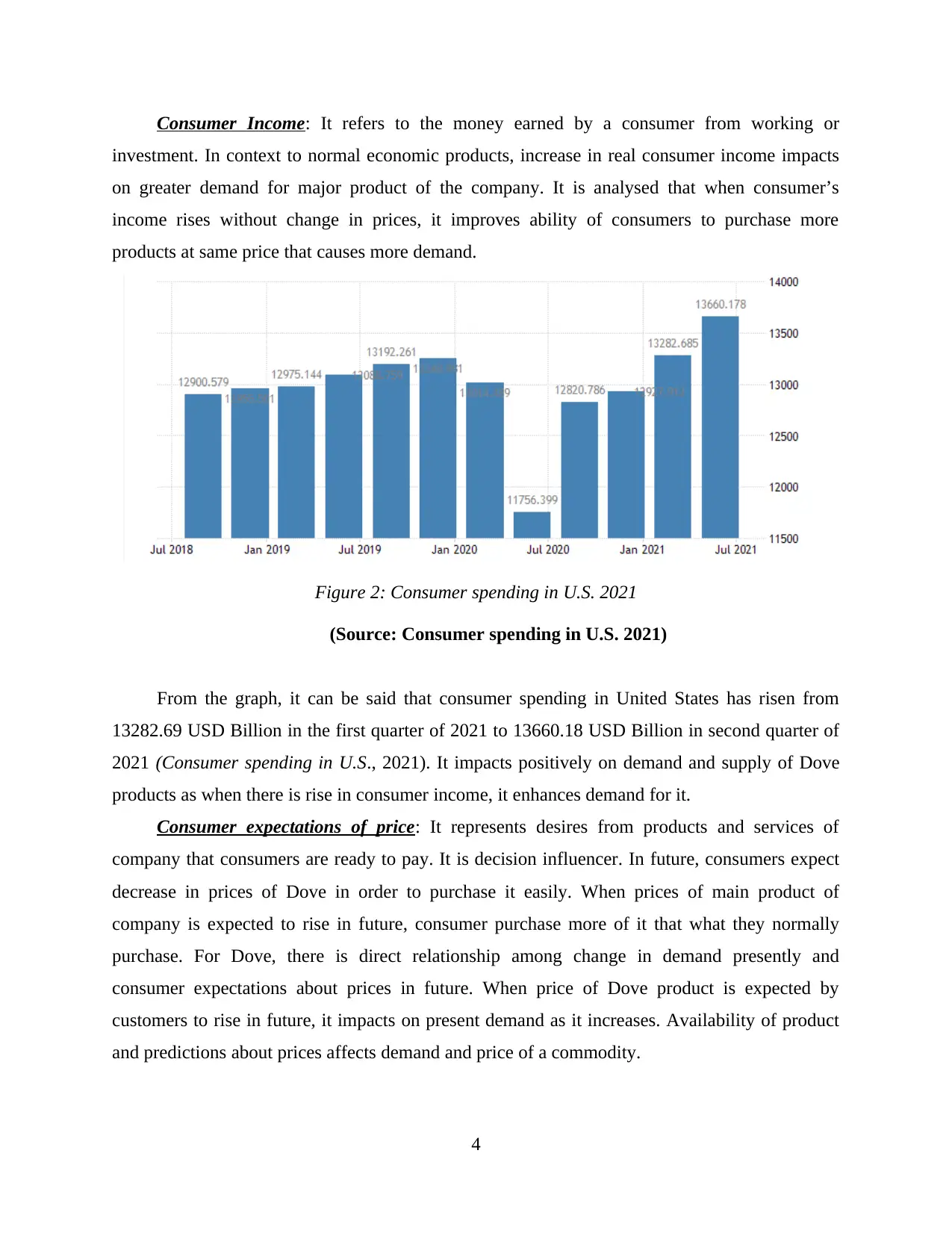
Consumer Income: It refers to the money earned by a consumer from working or
investment. In context to normal economic products, increase in real consumer income impacts
on greater demand for major product of the company. It is analysed that when consumer’s
income rises without change in prices, it improves ability of consumers to purchase more
products at same price that causes more demand.
Figure 2: Consumer spending in U.S. 2021
(Source: Consumer spending in U.S. 2021)
From the graph, it can be said that consumer spending in United States has risen from
13282.69 USD Billion in the first quarter of 2021 to 13660.18 USD Billion in second quarter of
2021 (Consumer spending in U.S., 2021). It impacts positively on demand and supply of Dove
products as when there is rise in consumer income, it enhances demand for it.
Consumer expectations of price: It represents desires from products and services of
company that consumers are ready to pay. It is decision influencer. In future, consumers expect
decrease in prices of Dove in order to purchase it easily. When prices of main product of
company is expected to rise in future, consumer purchase more of it that what they normally
purchase. For Dove, there is direct relationship among change in demand presently and
consumer expectations about prices in future. When price of Dove product is expected by
customers to rise in future, it impacts on present demand as it increases. Availability of product
and predictions about prices affects demand and price of a commodity.
4
investment. In context to normal economic products, increase in real consumer income impacts
on greater demand for major product of the company. It is analysed that when consumer’s
income rises without change in prices, it improves ability of consumers to purchase more
products at same price that causes more demand.
Figure 2: Consumer spending in U.S. 2021
(Source: Consumer spending in U.S. 2021)
From the graph, it can be said that consumer spending in United States has risen from
13282.69 USD Billion in the first quarter of 2021 to 13660.18 USD Billion in second quarter of
2021 (Consumer spending in U.S., 2021). It impacts positively on demand and supply of Dove
products as when there is rise in consumer income, it enhances demand for it.
Consumer expectations of price: It represents desires from products and services of
company that consumers are ready to pay. It is decision influencer. In future, consumers expect
decrease in prices of Dove in order to purchase it easily. When prices of main product of
company is expected to rise in future, consumer purchase more of it that what they normally
purchase. For Dove, there is direct relationship among change in demand presently and
consumer expectations about prices in future. When price of Dove product is expected by
customers to rise in future, it impacts on present demand as it increases. Availability of product
and predictions about prices affects demand and price of a commodity.
4
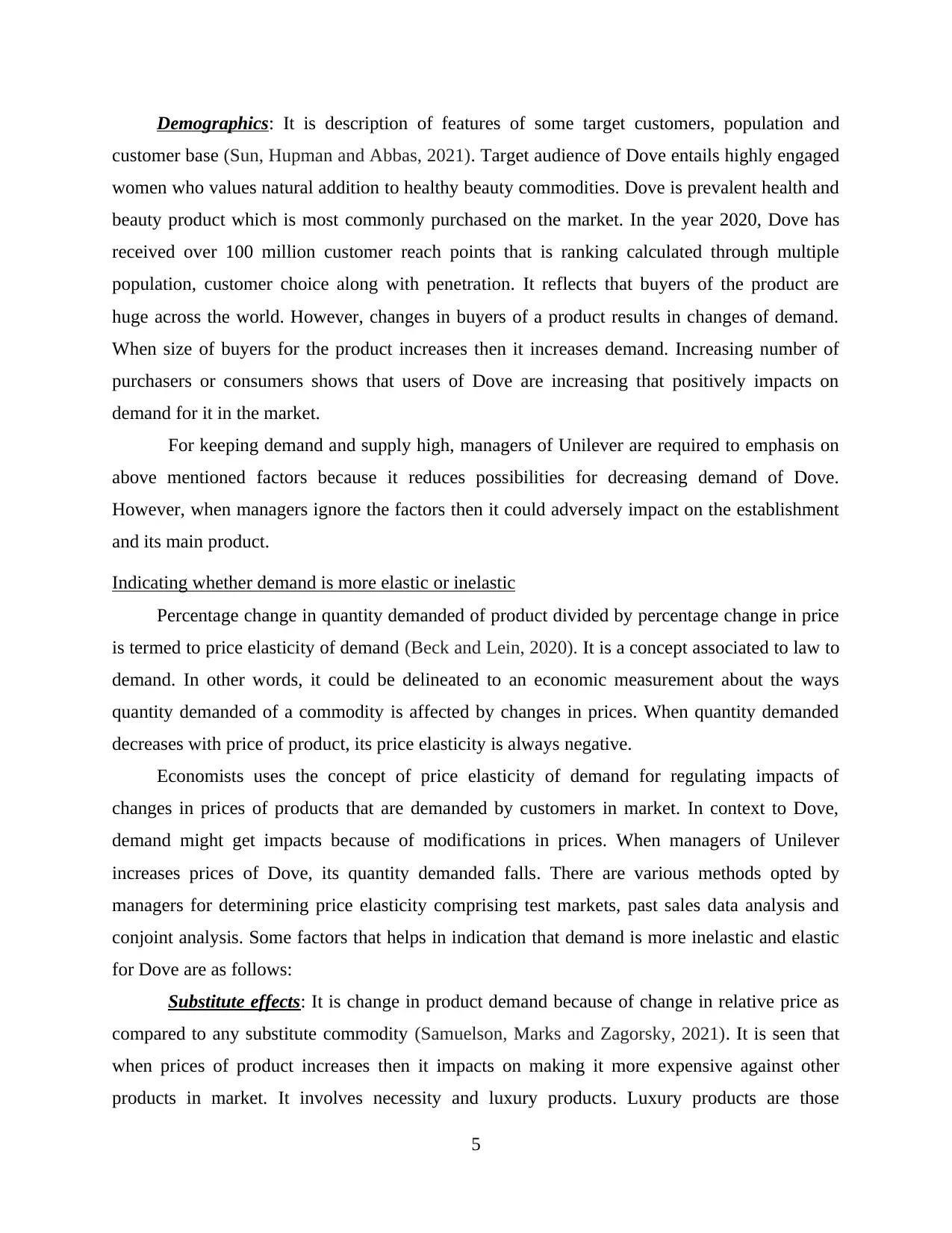
Demographics: It is description of features of some target customers, population and
customer base (Sun, Hupman and Abbas, 2021). Target audience of Dove entails highly engaged
women who values natural addition to healthy beauty commodities. Dove is prevalent health and
beauty product which is most commonly purchased on the market. In the year 2020, Dove has
received over 100 million customer reach points that is ranking calculated through multiple
population, customer choice along with penetration. It reflects that buyers of the product are
huge across the world. However, changes in buyers of a product results in changes of demand.
When size of buyers for the product increases then it increases demand. Increasing number of
purchasers or consumers shows that users of Dove are increasing that positively impacts on
demand for it in the market.
For keeping demand and supply high, managers of Unilever are required to emphasis on
above mentioned factors because it reduces possibilities for decreasing demand of Dove.
However, when managers ignore the factors then it could adversely impact on the establishment
and its main product.
Indicating whether demand is more elastic or inelastic
Percentage change in quantity demanded of product divided by percentage change in price
is termed to price elasticity of demand (Beck and Lein, 2020). It is a concept associated to law to
demand. In other words, it could be delineated to an economic measurement about the ways
quantity demanded of a commodity is affected by changes in prices. When quantity demanded
decreases with price of product, its price elasticity is always negative.
Economists uses the concept of price elasticity of demand for regulating impacts of
changes in prices of products that are demanded by customers in market. In context to Dove,
demand might get impacts because of modifications in prices. When managers of Unilever
increases prices of Dove, its quantity demanded falls. There are various methods opted by
managers for determining price elasticity comprising test markets, past sales data analysis and
conjoint analysis. Some factors that helps in indication that demand is more inelastic and elastic
for Dove are as follows:
Substitute effects: It is change in product demand because of change in relative price as
compared to any substitute commodity (Samuelson, Marks and Zagorsky, 2021). It is seen that
when prices of product increases then it impacts on making it more expensive against other
products in market. It involves necessity and luxury products. Luxury products are those
5
customer base (Sun, Hupman and Abbas, 2021). Target audience of Dove entails highly engaged
women who values natural addition to healthy beauty commodities. Dove is prevalent health and
beauty product which is most commonly purchased on the market. In the year 2020, Dove has
received over 100 million customer reach points that is ranking calculated through multiple
population, customer choice along with penetration. It reflects that buyers of the product are
huge across the world. However, changes in buyers of a product results in changes of demand.
When size of buyers for the product increases then it increases demand. Increasing number of
purchasers or consumers shows that users of Dove are increasing that positively impacts on
demand for it in the market.
For keeping demand and supply high, managers of Unilever are required to emphasis on
above mentioned factors because it reduces possibilities for decreasing demand of Dove.
However, when managers ignore the factors then it could adversely impact on the establishment
and its main product.
Indicating whether demand is more elastic or inelastic
Percentage change in quantity demanded of product divided by percentage change in price
is termed to price elasticity of demand (Beck and Lein, 2020). It is a concept associated to law to
demand. In other words, it could be delineated to an economic measurement about the ways
quantity demanded of a commodity is affected by changes in prices. When quantity demanded
decreases with price of product, its price elasticity is always negative.
Economists uses the concept of price elasticity of demand for regulating impacts of
changes in prices of products that are demanded by customers in market. In context to Dove,
demand might get impacts because of modifications in prices. When managers of Unilever
increases prices of Dove, its quantity demanded falls. There are various methods opted by
managers for determining price elasticity comprising test markets, past sales data analysis and
conjoint analysis. Some factors that helps in indication that demand is more inelastic and elastic
for Dove are as follows:
Substitute effects: It is change in product demand because of change in relative price as
compared to any substitute commodity (Samuelson, Marks and Zagorsky, 2021). It is seen that
when prices of product increases then it impacts on making it more expensive against other
products in market. It involves necessity and luxury products. Luxury products are those
5
Paraphrase This Document
Need a fresh take? Get an instant paraphrase of this document with our AI Paraphraser
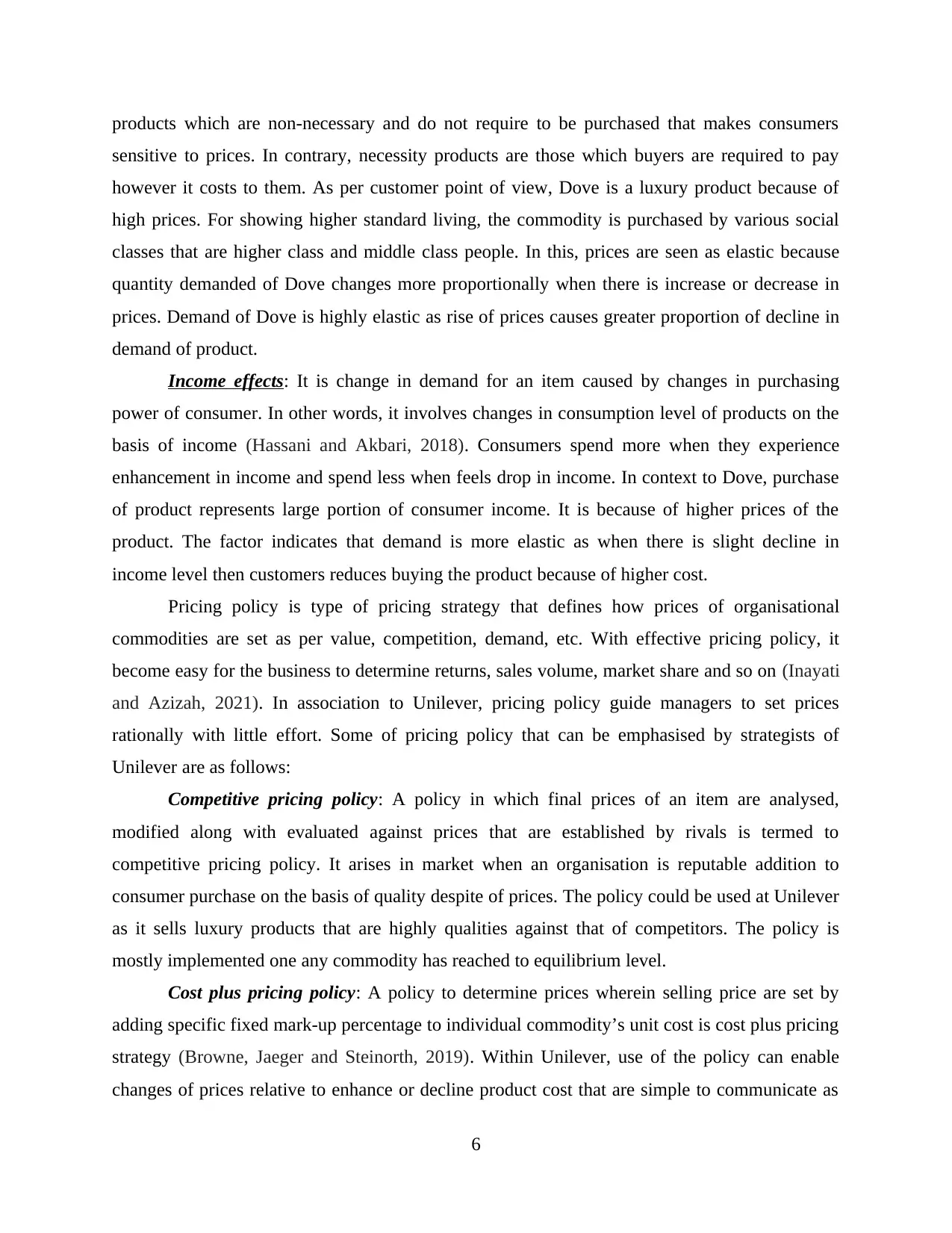
products which are non-necessary and do not require to be purchased that makes consumers
sensitive to prices. In contrary, necessity products are those which buyers are required to pay
however it costs to them. As per customer point of view, Dove is a luxury product because of
high prices. For showing higher standard living, the commodity is purchased by various social
classes that are higher class and middle class people. In this, prices are seen as elastic because
quantity demanded of Dove changes more proportionally when there is increase or decrease in
prices. Demand of Dove is highly elastic as rise of prices causes greater proportion of decline in
demand of product.
Income effects: It is change in demand for an item caused by changes in purchasing
power of consumer. In other words, it involves changes in consumption level of products on the
basis of income (Hassani and Akbari, 2018). Consumers spend more when they experience
enhancement in income and spend less when feels drop in income. In context to Dove, purchase
of product represents large portion of consumer income. It is because of higher prices of the
product. The factor indicates that demand is more elastic as when there is slight decline in
income level then customers reduces buying the product because of higher cost.
Pricing policy is type of pricing strategy that defines how prices of organisational
commodities are set as per value, competition, demand, etc. With effective pricing policy, it
become easy for the business to determine returns, sales volume, market share and so on (Inayati
and Azizah, 2021). In association to Unilever, pricing policy guide managers to set prices
rationally with little effort. Some of pricing policy that can be emphasised by strategists of
Unilever are as follows:
Competitive pricing policy: A policy in which final prices of an item are analysed,
modified along with evaluated against prices that are established by rivals is termed to
competitive pricing policy. It arises in market when an organisation is reputable addition to
consumer purchase on the basis of quality despite of prices. The policy could be used at Unilever
as it sells luxury products that are highly qualities against that of competitors. The policy is
mostly implemented one any commodity has reached to equilibrium level.
Cost plus pricing policy: A policy to determine prices wherein selling price are set by
adding specific fixed mark-up percentage to individual commodity’s unit cost is cost plus pricing
strategy (Browne, Jaeger and Steinorth, 2019). Within Unilever, use of the policy can enable
changes of prices relative to enhance or decline product cost that are simple to communicate as
6
sensitive to prices. In contrary, necessity products are those which buyers are required to pay
however it costs to them. As per customer point of view, Dove is a luxury product because of
high prices. For showing higher standard living, the commodity is purchased by various social
classes that are higher class and middle class people. In this, prices are seen as elastic because
quantity demanded of Dove changes more proportionally when there is increase or decrease in
prices. Demand of Dove is highly elastic as rise of prices causes greater proportion of decline in
demand of product.
Income effects: It is change in demand for an item caused by changes in purchasing
power of consumer. In other words, it involves changes in consumption level of products on the
basis of income (Hassani and Akbari, 2018). Consumers spend more when they experience
enhancement in income and spend less when feels drop in income. In context to Dove, purchase
of product represents large portion of consumer income. It is because of higher prices of the
product. The factor indicates that demand is more elastic as when there is slight decline in
income level then customers reduces buying the product because of higher cost.
Pricing policy is type of pricing strategy that defines how prices of organisational
commodities are set as per value, competition, demand, etc. With effective pricing policy, it
become easy for the business to determine returns, sales volume, market share and so on (Inayati
and Azizah, 2021). In association to Unilever, pricing policy guide managers to set prices
rationally with little effort. Some of pricing policy that can be emphasised by strategists of
Unilever are as follows:
Competitive pricing policy: A policy in which final prices of an item are analysed,
modified along with evaluated against prices that are established by rivals is termed to
competitive pricing policy. It arises in market when an organisation is reputable addition to
consumer purchase on the basis of quality despite of prices. The policy could be used at Unilever
as it sells luxury products that are highly qualities against that of competitors. The policy is
mostly implemented one any commodity has reached to equilibrium level.
Cost plus pricing policy: A policy to determine prices wherein selling price are set by
adding specific fixed mark-up percentage to individual commodity’s unit cost is cost plus pricing
strategy (Browne, Jaeger and Steinorth, 2019). Within Unilever, use of the policy can enable
changes of prices relative to enhance or decline product cost that are simple to communicate as
6
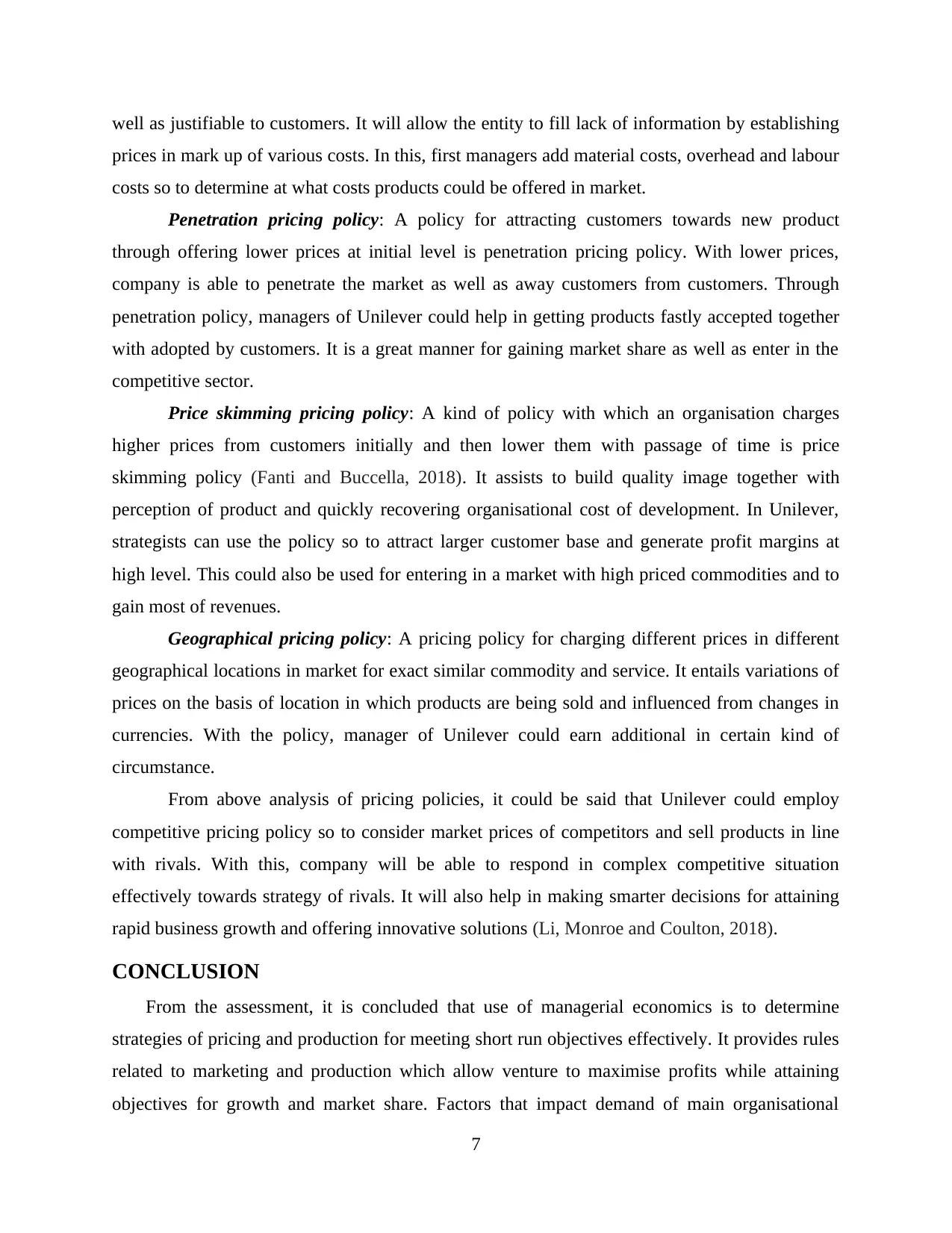
well as justifiable to customers. It will allow the entity to fill lack of information by establishing
prices in mark up of various costs. In this, first managers add material costs, overhead and labour
costs so to determine at what costs products could be offered in market.
Penetration pricing policy: A policy for attracting customers towards new product
through offering lower prices at initial level is penetration pricing policy. With lower prices,
company is able to penetrate the market as well as away customers from customers. Through
penetration policy, managers of Unilever could help in getting products fastly accepted together
with adopted by customers. It is a great manner for gaining market share as well as enter in the
competitive sector.
Price skimming pricing policy: A kind of policy with which an organisation charges
higher prices from customers initially and then lower them with passage of time is price
skimming policy (Fanti and Buccella, 2018). It assists to build quality image together with
perception of product and quickly recovering organisational cost of development. In Unilever,
strategists can use the policy so to attract larger customer base and generate profit margins at
high level. This could also be used for entering in a market with high priced commodities and to
gain most of revenues.
Geographical pricing policy: A pricing policy for charging different prices in different
geographical locations in market for exact similar commodity and service. It entails variations of
prices on the basis of location in which products are being sold and influenced from changes in
currencies. With the policy, manager of Unilever could earn additional in certain kind of
circumstance.
From above analysis of pricing policies, it could be said that Unilever could employ
competitive pricing policy so to consider market prices of competitors and sell products in line
with rivals. With this, company will be able to respond in complex competitive situation
effectively towards strategy of rivals. It will also help in making smarter decisions for attaining
rapid business growth and offering innovative solutions (Li, Monroe and Coulton, 2018).
CONCLUSION
From the assessment, it is concluded that use of managerial economics is to determine
strategies of pricing and production for meeting short run objectives effectively. It provides rules
related to marketing and production which allow venture to maximise profits while attaining
objectives for growth and market share. Factors that impact demand of main organisational
7
prices in mark up of various costs. In this, first managers add material costs, overhead and labour
costs so to determine at what costs products could be offered in market.
Penetration pricing policy: A policy for attracting customers towards new product
through offering lower prices at initial level is penetration pricing policy. With lower prices,
company is able to penetrate the market as well as away customers from customers. Through
penetration policy, managers of Unilever could help in getting products fastly accepted together
with adopted by customers. It is a great manner for gaining market share as well as enter in the
competitive sector.
Price skimming pricing policy: A kind of policy with which an organisation charges
higher prices from customers initially and then lower them with passage of time is price
skimming policy (Fanti and Buccella, 2018). It assists to build quality image together with
perception of product and quickly recovering organisational cost of development. In Unilever,
strategists can use the policy so to attract larger customer base and generate profit margins at
high level. This could also be used for entering in a market with high priced commodities and to
gain most of revenues.
Geographical pricing policy: A pricing policy for charging different prices in different
geographical locations in market for exact similar commodity and service. It entails variations of
prices on the basis of location in which products are being sold and influenced from changes in
currencies. With the policy, manager of Unilever could earn additional in certain kind of
circumstance.
From above analysis of pricing policies, it could be said that Unilever could employ
competitive pricing policy so to consider market prices of competitors and sell products in line
with rivals. With this, company will be able to respond in complex competitive situation
effectively towards strategy of rivals. It will also help in making smarter decisions for attaining
rapid business growth and offering innovative solutions (Li, Monroe and Coulton, 2018).
CONCLUSION
From the assessment, it is concluded that use of managerial economics is to determine
strategies of pricing and production for meeting short run objectives effectively. It provides rules
related to marketing and production which allow venture to maximise profits while attaining
objectives for growth and market share. Factors that impact demand of main organisational
7
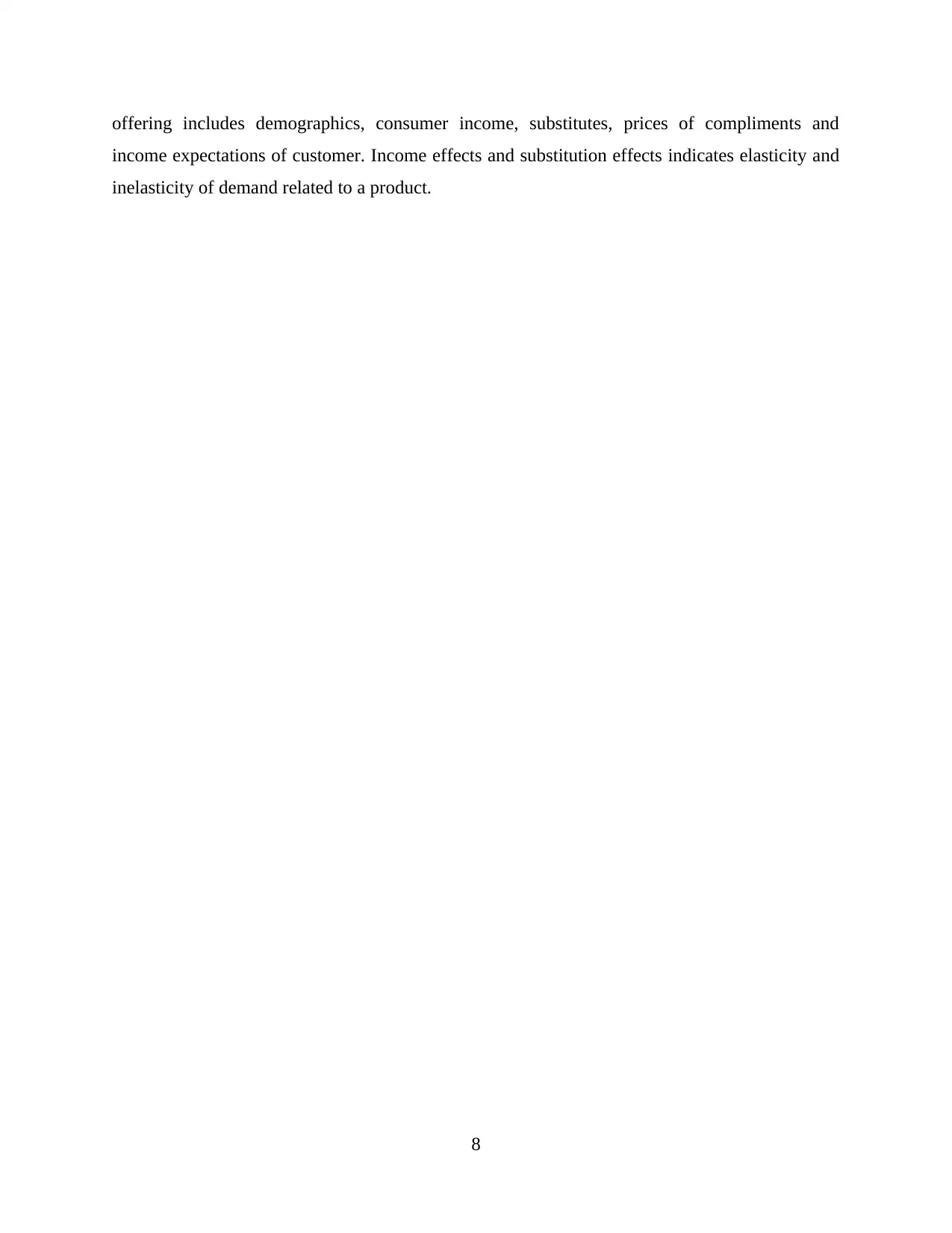
offering includes demographics, consumer income, substitutes, prices of compliments and
income expectations of customer. Income effects and substitution effects indicates elasticity and
inelasticity of demand related to a product.
8
income expectations of customer. Income effects and substitution effects indicates elasticity and
inelasticity of demand related to a product.
8
Secure Best Marks with AI Grader
Need help grading? Try our AI Grader for instant feedback on your assignments.
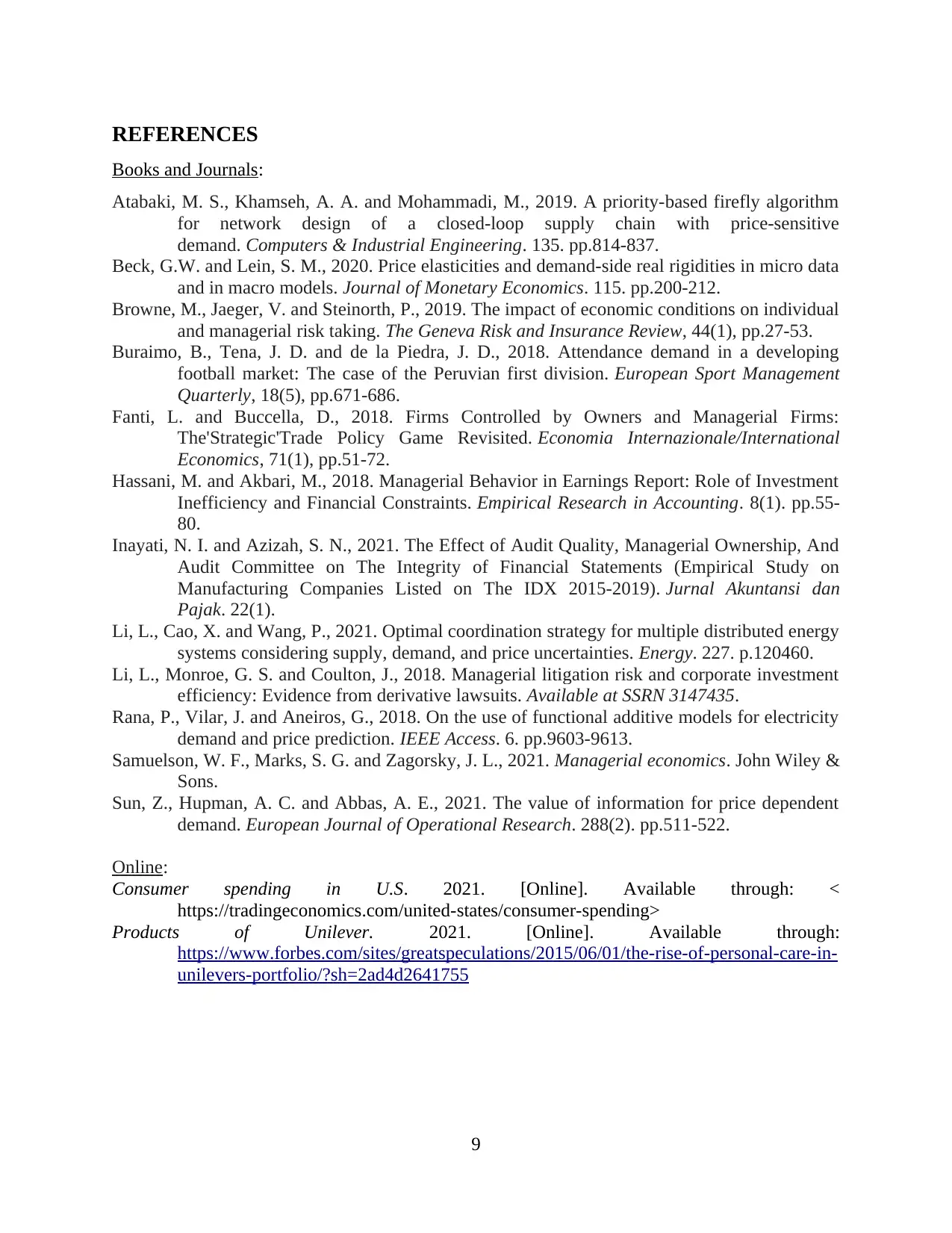
REFERENCES
Books and Journals:
Atabaki, M. S., Khamseh, A. A. and Mohammadi, M., 2019. A priority-based firefly algorithm
for network design of a closed-loop supply chain with price-sensitive
demand. Computers & Industrial Engineering. 135. pp.814-837.
Beck, G.W. and Lein, S. M., 2020. Price elasticities and demand-side real rigidities in micro data
and in macro models. Journal of Monetary Economics. 115. pp.200-212.
Browne, M., Jaeger, V. and Steinorth, P., 2019. The impact of economic conditions on individual
and managerial risk taking. The Geneva Risk and Insurance Review, 44(1), pp.27-53.
Buraimo, B., Tena, J. D. and de la Piedra, J. D., 2018. Attendance demand in a developing
football market: The case of the Peruvian first division. European Sport Management
Quarterly, 18(5), pp.671-686.
Fanti, L. and Buccella, D., 2018. Firms Controlled by Owners and Managerial Firms:
The'Strategic'Trade Policy Game Revisited. Economia Internazionale/International
Economics, 71(1), pp.51-72.
Hassani, M. and Akbari, M., 2018. Managerial Behavior in Earnings Report: Role of Investment
Inefficiency and Financial Constraints. Empirical Research in Accounting. 8(1). pp.55-
80.
Inayati, N. I. and Azizah, S. N., 2021. The Effect of Audit Quality, Managerial Ownership, And
Audit Committee on The Integrity of Financial Statements (Empirical Study on
Manufacturing Companies Listed on The IDX 2015-2019). Jurnal Akuntansi dan
Pajak. 22(1).
Li, L., Cao, X. and Wang, P., 2021. Optimal coordination strategy for multiple distributed energy
systems considering supply, demand, and price uncertainties. Energy. 227. p.120460.
Li, L., Monroe, G. S. and Coulton, J., 2018. Managerial litigation risk and corporate investment
efficiency: Evidence from derivative lawsuits. Available at SSRN 3147435.
Rana, P., Vilar, J. and Aneiros, G., 2018. On the use of functional additive models for electricity
demand and price prediction. IEEE Access. 6. pp.9603-9613.
Samuelson, W. F., Marks, S. G. and Zagorsky, J. L., 2021. Managerial economics. John Wiley &
Sons.
Sun, Z., Hupman, A. C. and Abbas, A. E., 2021. The value of information for price dependent
demand. European Journal of Operational Research. 288(2). pp.511-522.
Online:
Consumer spending in U.S. 2021. [Online]. Available through: <
https://tradingeconomics.com/united-states/consumer-spending>
Products of Unilever. 2021. [Online]. Available through:
https://www.forbes.com/sites/greatspeculations/2015/06/01/the-rise-of-personal-care-in-
unilevers-portfolio/?sh=2ad4d2641755
9
Books and Journals:
Atabaki, M. S., Khamseh, A. A. and Mohammadi, M., 2019. A priority-based firefly algorithm
for network design of a closed-loop supply chain with price-sensitive
demand. Computers & Industrial Engineering. 135. pp.814-837.
Beck, G.W. and Lein, S. M., 2020. Price elasticities and demand-side real rigidities in micro data
and in macro models. Journal of Monetary Economics. 115. pp.200-212.
Browne, M., Jaeger, V. and Steinorth, P., 2019. The impact of economic conditions on individual
and managerial risk taking. The Geneva Risk and Insurance Review, 44(1), pp.27-53.
Buraimo, B., Tena, J. D. and de la Piedra, J. D., 2018. Attendance demand in a developing
football market: The case of the Peruvian first division. European Sport Management
Quarterly, 18(5), pp.671-686.
Fanti, L. and Buccella, D., 2018. Firms Controlled by Owners and Managerial Firms:
The'Strategic'Trade Policy Game Revisited. Economia Internazionale/International
Economics, 71(1), pp.51-72.
Hassani, M. and Akbari, M., 2018. Managerial Behavior in Earnings Report: Role of Investment
Inefficiency and Financial Constraints. Empirical Research in Accounting. 8(1). pp.55-
80.
Inayati, N. I. and Azizah, S. N., 2021. The Effect of Audit Quality, Managerial Ownership, And
Audit Committee on The Integrity of Financial Statements (Empirical Study on
Manufacturing Companies Listed on The IDX 2015-2019). Jurnal Akuntansi dan
Pajak. 22(1).
Li, L., Cao, X. and Wang, P., 2021. Optimal coordination strategy for multiple distributed energy
systems considering supply, demand, and price uncertainties. Energy. 227. p.120460.
Li, L., Monroe, G. S. and Coulton, J., 2018. Managerial litigation risk and corporate investment
efficiency: Evidence from derivative lawsuits. Available at SSRN 3147435.
Rana, P., Vilar, J. and Aneiros, G., 2018. On the use of functional additive models for electricity
demand and price prediction. IEEE Access. 6. pp.9603-9613.
Samuelson, W. F., Marks, S. G. and Zagorsky, J. L., 2021. Managerial economics. John Wiley &
Sons.
Sun, Z., Hupman, A. C. and Abbas, A. E., 2021. The value of information for price dependent
demand. European Journal of Operational Research. 288(2). pp.511-522.
Online:
Consumer spending in U.S. 2021. [Online]. Available through: <
https://tradingeconomics.com/united-states/consumer-spending>
Products of Unilever. 2021. [Online]. Available through:
https://www.forbes.com/sites/greatspeculations/2015/06/01/the-rise-of-personal-care-in-
unilevers-portfolio/?sh=2ad4d2641755
9
1 out of 11
Related Documents
Your All-in-One AI-Powered Toolkit for Academic Success.
+13062052269
info@desklib.com
Available 24*7 on WhatsApp / Email
![[object Object]](/_next/static/media/star-bottom.7253800d.svg)
Unlock your academic potential
© 2024 | Zucol Services PVT LTD | All rights reserved.





